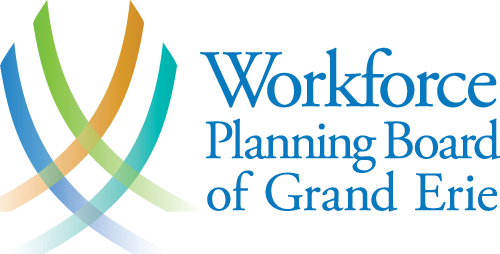EmployerOne 2023
Survey Results

The Workforce Planning Board of Grand Erie conducted its 8th EmployerOne survey in January 2023.
The EmployerOne survey is carried out by workforce development boards across Ontario in order to better understand labour market demands and changes.
Wynona Mendes is the Research Lead at Workforce Planning Board of Grand Erie. With a Master of Economic Development and Innovation from the University of Waterloo, she uses local data to identify and analyze trends in the labour market, providing insights into the employment landscape. This analysis helps employers, community partners and leaders make sense of the labour market.
A total of 249 businesses completed the 2023 EmployerOne, the first survey of its kind since 2020, prior to the pandemic. Mendes’ analysis of the 2023 survey is below.
Scroll down to view the report or download a PDF copy by clicking the button below. You can also watch our EmployerOne 2023 video.

Wynona Mendes
Research Lead
Workforce Planning Board
of Grand Erie
Availability of Qualified Workers
Employers had difficulties filling roles of all skill levels, but technical and general labour roles were hardest to fill, with about 35% of businesses rating availability as ‘poor’, and an even higher proportion rating it as ‘fair’.
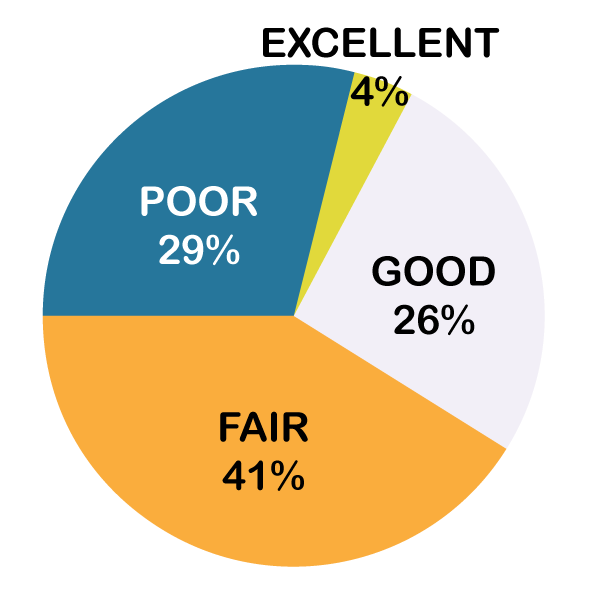
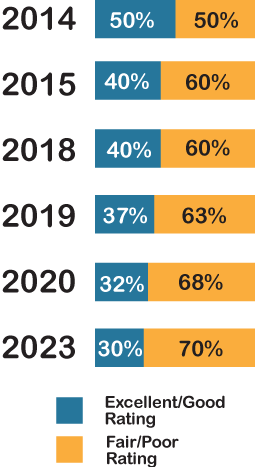
Shifts In Availability
Shifts in availability of qualified workers between 2014 and 2023.
Anticipated Hiring
- 77% of all businesses anticipate hiring in 2023, similar to pre-pandemic levels
- Since 2019, the main reason for anticipated hiring has been to fill vacancies/replacements, with over 1 in 3 businesses (38%) citing this as the principal reason for hiring in 2023.
- Anticipated hiring was most common in sectors experiencing labour shortages, namely:
- Accommodation and food services – 86% [Main reason: Fill a vacancy/replacement]
- Manufacturing – 84% [Main reason: Fill a vacancy/replacement]
- Agriculture – 83% [Main reason: Expansion]
- Healthcare and social assistance – 81% [Main reason: Fill a vacancy/replacement]
- Wholesale and retail trade – 71% [Main reason: Fill a vacancy/replacement]
- 91% of City of Brantford businesses planned to hire in 2023 (higher than all of the counties)

Hard to Fill Positions

Hard to Fill Positions
Reasons for hard to fill positions:
- Not enough applicants (indicated by 40% of all businesses)
- Lack of work experience amongst candidates (indicated by 33% of all businesses)
- Lack of motivation, attitude or interpersonal abilities amongst candidates (indicated by 32% of all businesses)
- Candidates do not show up for interviews/respond to job offers (indicated by 31% of all businesses)
- Lack of qualifications (education/certifications) amongst candidates (indicated by 28% of all businesses)
Top reason by sector:
- Manufacturing – Candidates do not show up for interviews/respond to offers
- Healthcare and Social Assistance – Lack of qualifications (education/certifications) amongst candidates
- Wholesale and retail trade – Not enough applicants
- Construction – Lack of work experience amongst candidates
- Accommodation and Food Services – Candidates do not show up for interviews/respond to offers
- Agriculture – Lack of work experience amongst candidates
To address hard-to-fill roles, businesses have tried the following:
- 83% offered on the job training (of these, 62% were successful)
- 73% offered better wages/benefits (of these, 55% were successful)
- 60% reduced experience requirements (of these, 37% were successful)
- 58% hired one or more part-time staff to fill a full-time role (of these, 54% were successful)
- 49% reduced qualification requirements (of these, 35% were successful)
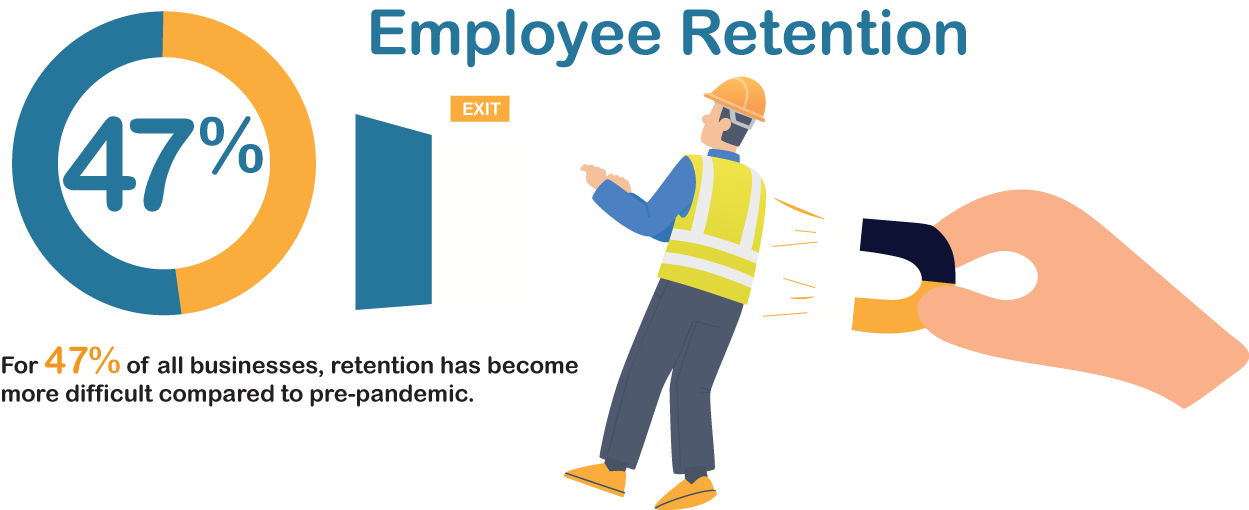
Retention
- The proportion of businesses that indicated that retention has become more challenging since pre-pandemic was even higher for manufacturing (60%), healthcare (56%), and accommodation and food service (52%) businesses.
- It was also more common for government (63%) and not-for-profit (55%) businesses.
- The proportion of businesses with retention challenges increased along with business size.
Reasons for increased retention challenges:
- We cannot offer competitive wages – 26% (common amongst healthcare, accommodation and food service and manufacturing businesses)
- Undesirable work hours (i.e. rotating, split, on call hours) – 18% (common amongst agricultural businesses)
- Limited/no benefits – 13% (common amongst professional, scientific and technical services businesses)
- Lack of transportation availability – 13% (common amongst Six Nations, and Brant, Haldimand and Norfolk county businesses)
- Not enough opportunities to advance/develop within business – 10% (common amongst manufacturing businesses)
- Too many hours required – 10% (common amongst agriculture businesses)
Separations
- 75% of all businesses experienced separations in 2022.
- Separations by sector:
- Manufacturing- 91%
- Agriculture – 83%
- Healthcare and Social Assistance – 81%
- Wholesale and Retail Trade – 74%
- Construction – 73%
- Accommodation and Food Services – 69%
- Professional, Scientific and Technical Services – 39%
- Amongst businesses that experienced separations, 63% indicated they completed exit interviews. Exit interviews were most common in the manufacturing sector, and least common in the accommodation and food services sector.
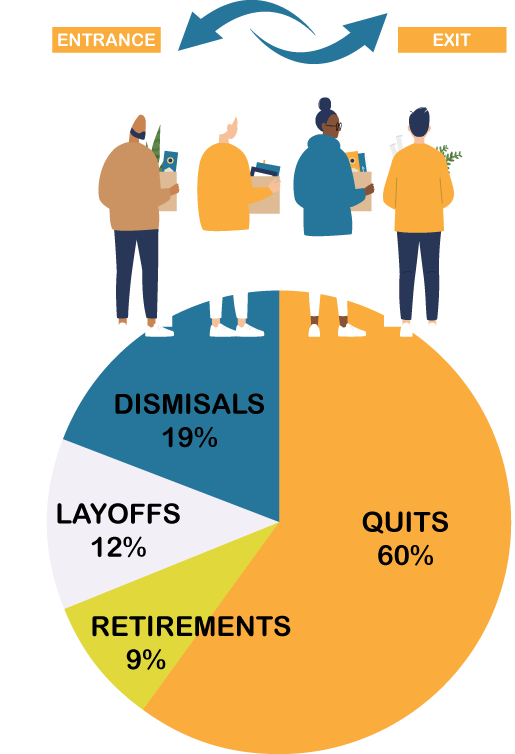

Impacts of hiring and retention challenges
- As a result of hiring and retention challenges:
- 68% of businesses reported transferring responsibilities to existing staff members
- 55% of businesses reported reduced productivity
- 37% of businesses reported negative impact on customer service
Other significant impacts included inability to get/fulfill contracts, reduced business hours/elimination of shifts, postponed business expansion and inability to meet financial goals.
Remote Work
40% of Grand Erie businesses switched to remote work over the pandemic. This was most common amongst professional, scientific, and technical services, healthcare and social assistance, and manufacturing, and least common amongst accommodation and food services and agricultural businesses.
77% of these businesses continue to allow their workforce to work remotely either partially or fully.
Majority (55%) of businesses reported no change in productivity as a result of remote work. 16% said productivity increased, and 29% said it decreased as a result of remote work.
Amongst businesses that didn’t require in-person work, the main reason for calling employees back to the workplace was because employers found it difficult to manage remote workers.


Equity, Diversity and Inclusion
- On their senior management teams, 20% of businesses had racialized persons, 10% had Indigenous persons, 9% had members of the 2SLGBTQIA+ community and 8% had persons with disabilities.
- 78% of all businesses agreed that hiring with a lens to diversify the workforce is an important part of their organization’s strategy, and a slightly smaller portion (74%) indicated they were aware of organizations that can help improve their EDI (Equity, Diversity and Inclusion) practices. However, only 36% had worked with such organizations to improve their EDI practices.
- 43% of businesses said their management had completed EDI training, and 31% said all their staff had done the same.
Mental Health Leave
- 24% of businesses indicated they had experienced an increase in mental health leave amongst employees. This was most common amongst accommodation and food services (45%), health care and social assistance (33%), and manufacturing (29%) businesses.

Micro-credentials
- We do not have any needs that may be filled by micro-credential training- 44%
- We have not considered accepting micro-credentials – 26%
- We accept micro-credentials from recognized institutions – 23%
- We accept micro-credentials only from formal higher education institutions (i.e. universities/colleges) – 6%
- We have considered, but do not accept micro-credentials – 2%
IT provisions
- 20% of all businesses did not have any IT support, and an additional 45% relied on the services of an external IT consultant/contractor. The vast majority of these were micro and small businesses.
Cybersecurity needs
- A majority (52%) of businesses have strong cybersecurity systems in place. Meanwhile, 12% (mostly micro and small businesses) were unsure of what their cybersecurity needs were, and an additional 13% did not have the resources to focus on cybersecurity at this time.
- 20% of businesses said their cybersecurity systems need improvement.
Wynona Mendes is the Research Lead at Workforce Planning Board of Grand Erie. In this video, Mendes provides a break down of the 2023 EmployerOne survey and the relevance of its findings for partners, employers and the community.

The Workforce Planning Board of Grand Erie is the labour market expert in the communities of Brantford, Brant, Haldimand, Norfolk, Six Nations and Mississaugas of the Credit. We are one of 26 community-based, not-for-profit corporations established in Ontario to play a leadership role in labour force development.
The Workforce Planning Board of Grand Erie leads the development of local labour market strategies by engaging community partners and maximizing available resources.




